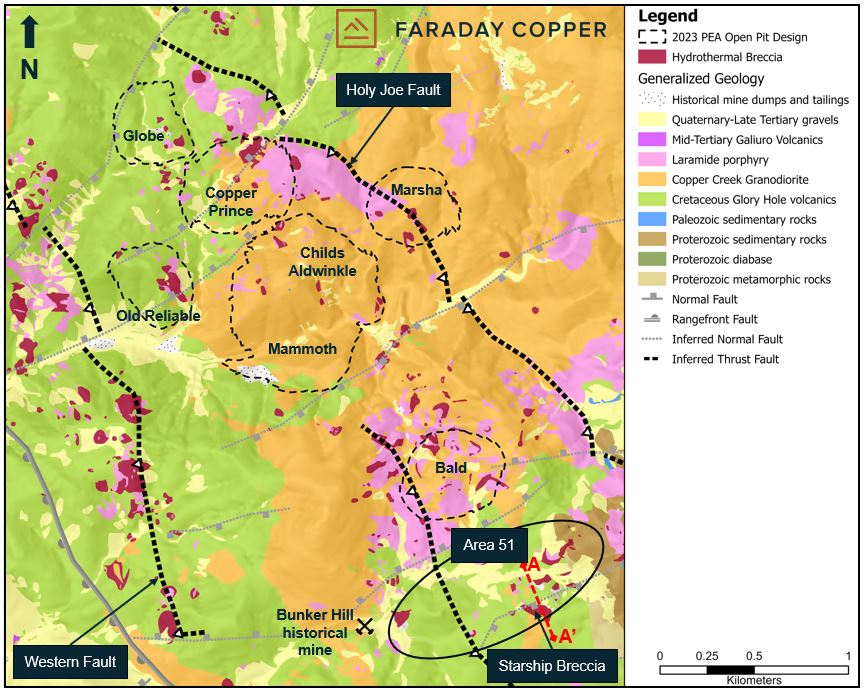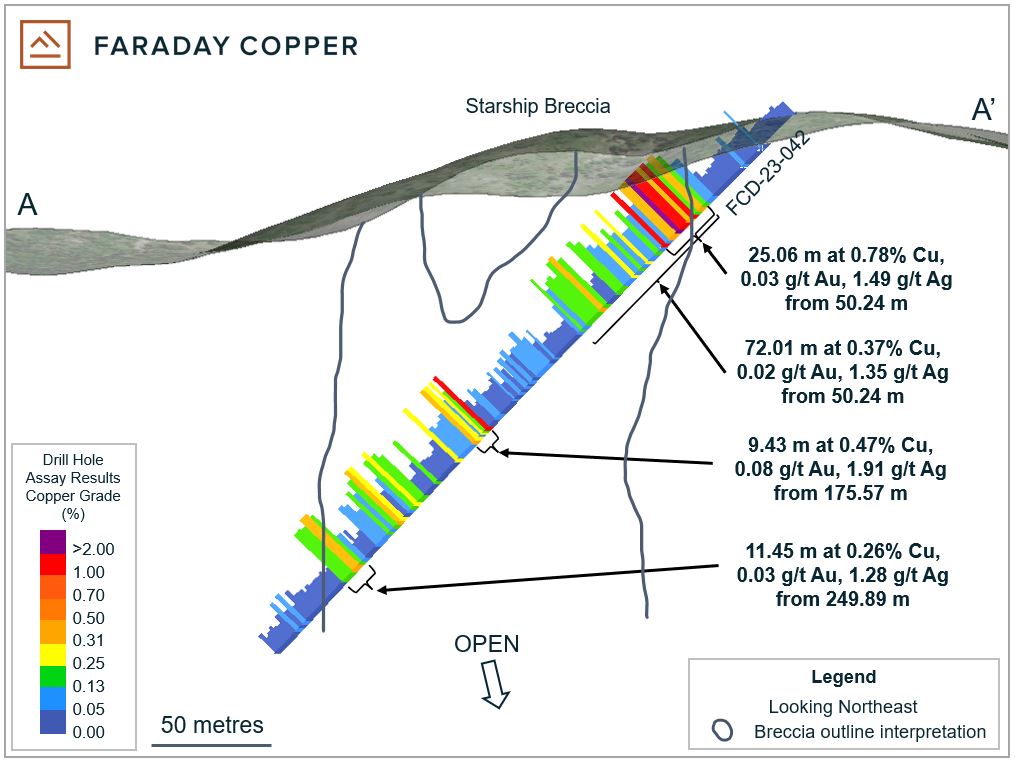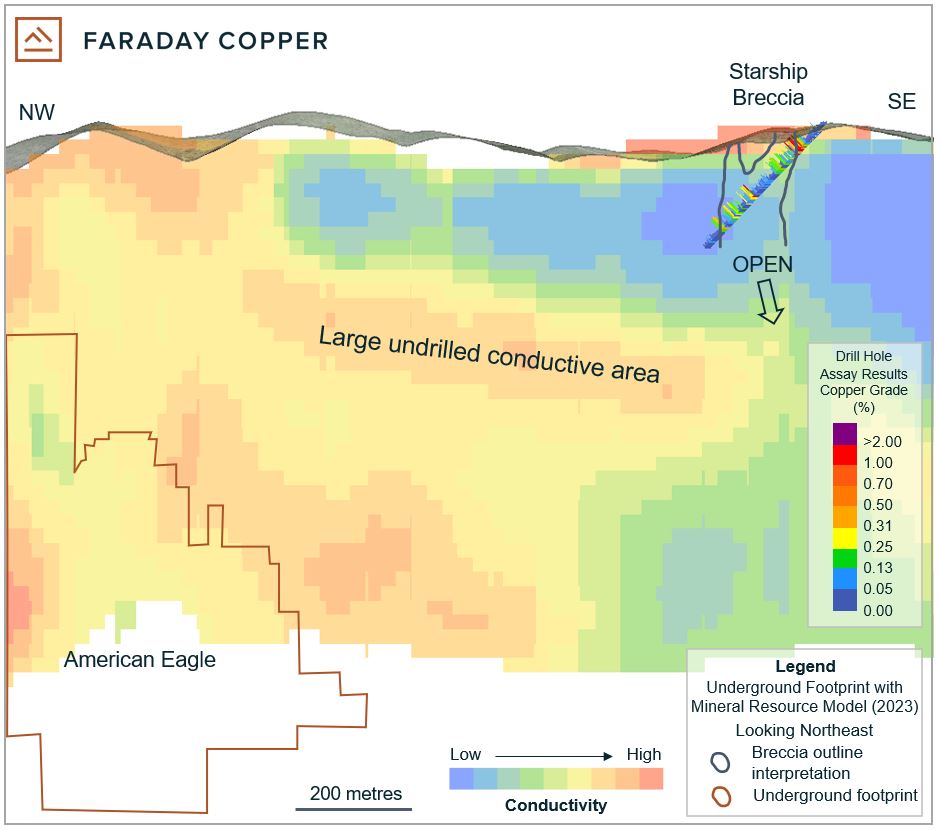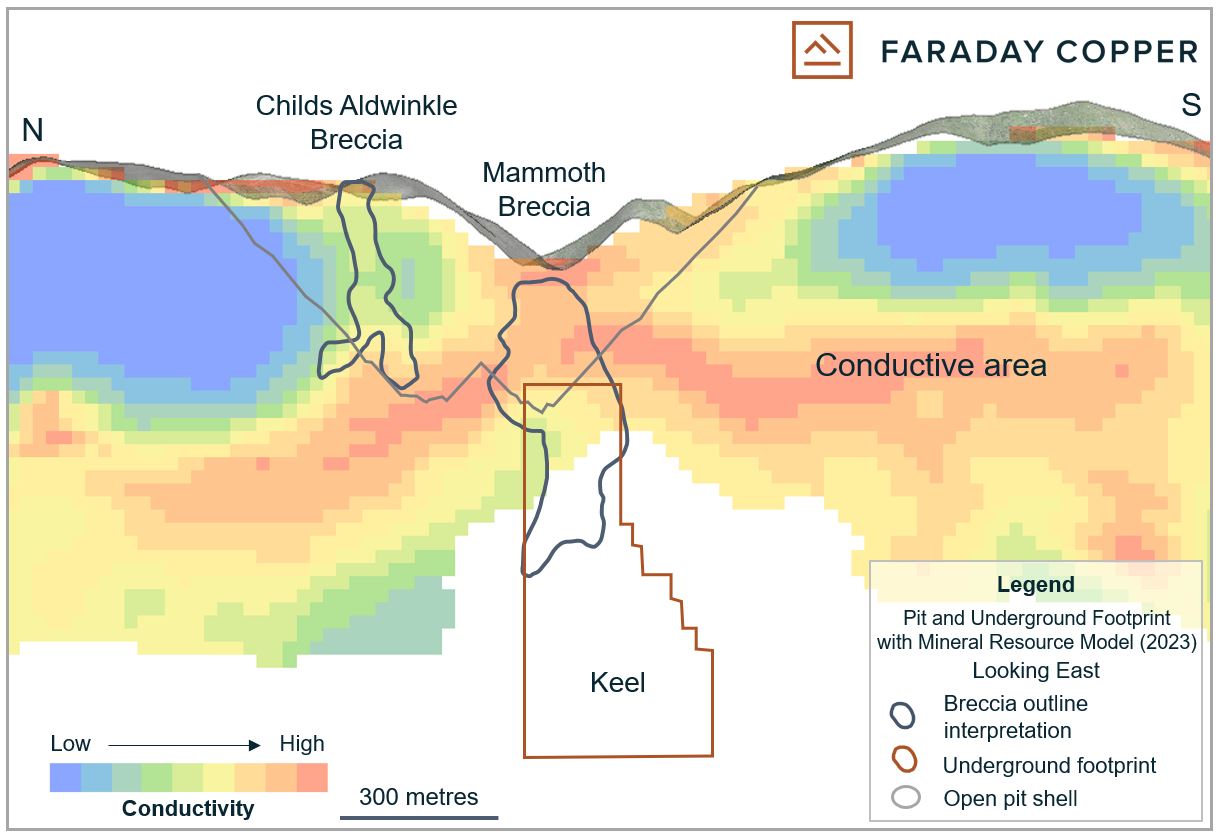par Faraday Copper Corp. (isin : CA2176212009)
Faraday Copper Discovers New Mineralized Breccia 800 Meters Southeast of the Existing Mineral Resource
VANCOUVER, BC / ACCESSWIRE / January 16, 2024 / Faraday Copper Corp. ("Faraday" or the "Company") (TSX:FDY)(OTCQX:CPPKF) is pleased to announce the results from the first two reconnaissance drill holes of its Phase III program at the Copper Creek Project, located in Arizona, U.S. ("Copper Creek"). The holes intersected a newly identified breccia at the Area 51 target ("Starship"), which has the potential to increase the open pit Mineral Resource Estimate ("MRE"). The Company also provides Gold Program results from the Copper Prince breccia.
Paul Harbidge, President and CEO, commented "It's exciting to start the Phase III drill program with a new discovery that supports the district scale exploration upside at Copper Creek. The new Starship discovery is interpreted to be related to a different mineralized system that is distinct from the Copper Creek MRE. Our geophysical and spectral data demonstrates that the Starship breccia displays similar characteristics to other known mineralized breccias at Copper Creek and suggests it is located at the top of a larger hydrothermal system that is open both laterally and at depth. Follow up drilling during the Phase III program will target the lateral extension and deeper parts of this breccia complex."
Highlights
- Intersected 72.01 metres ("m") at 0.37% copper, 0.02 grams per tonne ("g/t") gold and 1.35 g/t silver from 50.24 m, including 25.06 m at 0.78% copper, 0.03 g/t gold and 1.49 g/t silver from 50.24 m in drill hole FCD-23-042 at the previously undrilled Starship breccia (Figure 1 and 2).
- Drill hole FCD-23-042 also intersected 225.52 m of hydrothermal breccia from 57.00 m which contains the following additional mineralized intersections: 9.43 m at 0.47% copper, 0.08 g/t gold and 1.91 g/t silver from 175.57 m and 11.45 m at 0.26% copper, 0.03 g/t gold and 1.28 g/t silver from 249.89 m (Figure 1 and 2).
- Drill hole FCD-23-041 intersected 29.86 m at 0.26% copper, 0.08 g/t gold and 2.10 g/t silver from 185.29 m, including 13.94 m at 0.42% copper, 0.13 g/t gold and 2.29 g/t silver from 185.29 m (Figure 3). This intersection is contained within a 102.13-metre-long breccia intersection from 131.12 m.
- The new Starship discovery has the potential to increase the open pit mineral resource and the mineralization remains open laterally and at depth. Sulphide mineralogy and trace element geochemistry, together with geophysical evidence, suggest that the drill holes intercepted a shallow part of the mineral system, which includes a near-surface supergene enrichment zone.
(For true width information see Table 1.)
Area 51 (Figure 1) was identified as highly prospective by integrating airborne versatile time domain electromagnetic ("VTEM") data and short wave infrared spectral data together with geological mapping and sampling. It is a broad southwest-northeast trending zone, approximately 800 m southeast of the Copper Creek mineral resource. More than 15 breccia occurrences along with southwest trending vein zones and widespread sericite alteration are documented over an area of approximately 1,000 m by 400 m between the historical Bunker Hill mine and east of the Starship breccia. The latter is part of the eastern breccia trend which hosts the Copper Creek mineral resource. This breccia trend is interpreted to follow the hanging wall of the northwest trending Holy Joe thrust fault, which brought Proterozoic metamorphic rocks in contact with younger sedimentary rock units to the east of Area 51. This fault is also thought to have controlled the emplacement of the Paleocene Glory Hole volcanics and Copper Creek granodiorite which host the mineralization at Copper Creek.
The airborne VTEM data for Area 51 highlights an area of conductivity which is potentially sulphide-bearing (Figure 4A). Known mineralized breccias at Mammoth and Childs Aldwinkle are associated with areas of elevated conductivity cross cutting more resistive surrounding rocks (Figure 4B). Figures 4A and 4B are presented for comparative purposes.
Drill hole FCD-23-042 was collared south of the Starship breccia outcrop and drilled to the north-northwest. The mineralization occurs as chalcopyrite and chalcocite cement within a hydrothermal breccia, which also includes pyrite and quartz. The hole intersected over 225 m of hydrothermal breccia with several mineralized intervals (Figures 1 and 2). The mineralization and alteration suggest that the intersection is in the upper part of the mineralized system and remains open laterally and at depth.
Drill hole FCD-23-041 was collared approximately 125 m to the northeast from drill hole FCD-23-042 and was drilled to the west-northwest. The mineralization is similar to hole FCD-23-042 and occurs as chalcopyrite and chalcocite cement within hydrothermal breccia (Figure 3). It intersected over 100 m of hydrothermal breccia.
Figure 1: Plan View Showing Surface Geology and Target Location
Note: The open pit design is based on constraints used in the MRE as presented in the report titled "Copper Creek Project NI 43-101 Technical Report and Preliminary Economic Assessment" with an effective date of May 3, 2023 (the "Technical Report") available on the Company's website at www.faradaycopper.com and on the Company's SEDAR+ profile at www.sedarplus.ca.
Figure 2: Cross Section Showing Drill Hole FCD-23-042
Figure 3: A typical core sample from drill hole FDY-23-041 (187.4 m to 187.6 m)
Note: The underground footprint is based on constraints used in the MRE as reported in the Technical Report.
Note: The open pit shell and underground footprint are based on constraints used in the MRE as reported in the Technical Report.
Table 1: Selected Drill Results from Copper Creek
| Drill Hole ID | From | To | Length | True Width | Cu | Au | Ag | Mo |
(m) | (m) | (m) | (m) | (%) | (g/t) | (g/t) | (%) | |
| FCD-23-042 | 50.24 | 122.25 | 72.01 | 51 | 0.37 | 0.02 | 1.35 | 0.0003 |
| including | 50.24 | 75.30 | 25.06 | 18 | 0.78 | 0.03 | 1.49 | 0.0003 |
| and | 175.57 | 195.00 | 19.43 | 14 | 0.28 | 0.09 | 1.61 | 0.0003 |
| including | 175.57 | 185.00 | 9.43 | 7 | 0.47 | 0.08 | 1.91 | 0.0005 |
| and | 213.22 | 235.00 | 21.78 | 15 | 0.19 | 0.03 | 0.94 | 0.0001 |
| and | 249.89 | 261.34 | 11.45 | 8 | 0.26 | 0.03 | 1.28 | 0.0003 |
| FCD-23-041 | 185.29 | 215.15 | 29.86 | 21 | 0.26 | 0.08 | 2.10 | 0.0004 |
| including | 185.29 | 199.23 | 13.94 | 10 | 0.42 | 0.13 | 2.29 | 0.0003 |
Notes: All intercepts are reported as downhole drill widths. Due to the insufficiently constrained geometry and irregular shape of mineralized domains, true widths are approximate.
Table 2: Collar Locations from the Drill Holes Reported Herein
| Drill Hole ID | Easting | Northing | Elevation | Azimuth | Dip | Target | Depth | Depth |
(m) | (°) | (°) | (ft) | (m) | ||||
| FCD-23-042 | 549759 | 3622259 | 1390 | 340 | 45 | Starship Breccia | 916.2 | 300.59 |
| FCD-23-041 | 549845 | 3622350 | 1372 | 282 | 45 | Starship Breccia | 808.7 | 265.33 |
Note: Coordinates are given as World Geodetic System 84, Universal Transverse Mercator Zone 12 north (WGS84, UTM12N).
Gold Program Update
The Company is continuing the re-assaying of historical material for potential inclusion of gold in future mineral resource updates. Several historical drill holes from Copper Prince have been analyzed for gold and results are shown in Table 3. In addition to gold assays, samples were re-analyzed for copper and molybdenum and the results validate historical analysis. The Company continues to advance the re-assay program with current focus on the Keel underground zone.
Table 3: Results for Intercepts for the Copper Prince Breccia
| Drill Hole ID | From | To | Length | True Width | Cu | Au | Ag | Mo |
(m) | (m) | (m) | (m) | (%) | (g/t) | (g/t) | (%) | |
| CP1 | 79.25 | 161.54 | 82.29 | 56 | 1.54 | 0.07 | 2.84 | 0.007 |
| CP2 | 109.73 | 140.21 | 30.48 | 23 | 1.67 | 0.09 | 4.63 | 0.001 |
| CP3 | 0.00 | 97.54 | 97.54 | 38 | 2.37 | 0.07 | 5.44 | 0.029 |
| CP4 | 76.20 | 106.68 | 30.48 | 7 | 1.67 | 0.03 | 5.38 | 0.001 |
| CP5 | No significant values | |||||||
| CP6 | No significant values | |||||||
| RCP-08-026 | 29.57 | 65.23 | 35.66 | 25 | 1.10 | 0.02 | 3.91 | 0.008 |
| RCP-08-027 | 16.46 | 53.34 | 36.88 | 9 | 1.33 | 0.03 | 3.16 | 0.009 |
| RCP-08-028 | 34.75 | 92.45 | 57.70 | 29 | 0.56 | 0.02 | 1.37 | 0.007 |
| RCP-08-030 | 123.75 | 138.68 | 14.93 | 4 | 0.53 | 0.03 | 1.38 | 0.018 |
| and | 143.87 | 156.36 | 12.49 | 3 | 0.39 | 0.02 | 1.09 | 0.011 |
| and | 227.08 | 243.54 | 16.46 | 4 | 0.46 | 0.03 | 2.27 | 0.027 |
| RCP-08-038 | 7.01 | 37.49 | 30.48 | 8 | 1.27 | 0.03 | 3.94 | 0.016 |
| FCD-22-013 | 234.27 | 249.28 | 15.01 | 11 | 10.83 | 1.65 | 55.62 | 0.014 |
| FCD-22-018 | 103.17 | 155.55 | 52.38 | 37 | 1.05 | 0.03 | 1.35 | 0.010 |
Notes: All intercepts are reported as downhole drill widths. True widths are approximate due to the irregular shapes of the mineralized domains. Drill holes CP1 through CP6 are re-analyzed holes; drill holes named RCP are holes historically analyzed by Redhawk Copper Corp.; drill holes named FCD correspond to Faraday's previously reported intercepts. Intercepts greater than 0.13% copper are listed in this table.
Next Steps
Phase III drilling continues and is focused on three objectives:
- Reconnaissance drilling on new targets;
- Expanding the MRE; and
- Better delineating high-grade mineralized zones.
As part of the Phase III program, three drill holes have been completed in Area 51 and the results for two holes have been released to date. Additional holes are currently being designed to test the lateral and depth extent of this new mineralization. Three holes were drilled in the Bald area and two holes near the Copper Prince area and the assay results will be released as they are received, analyzed and confirmed by the Company.
Sampling Methodology, Chain of Custody, Quality Control and Quality Assurance
All sampling was conducted under the supervision of the Company's geologists and the chain of custody from Copper Creek to the independent samp






